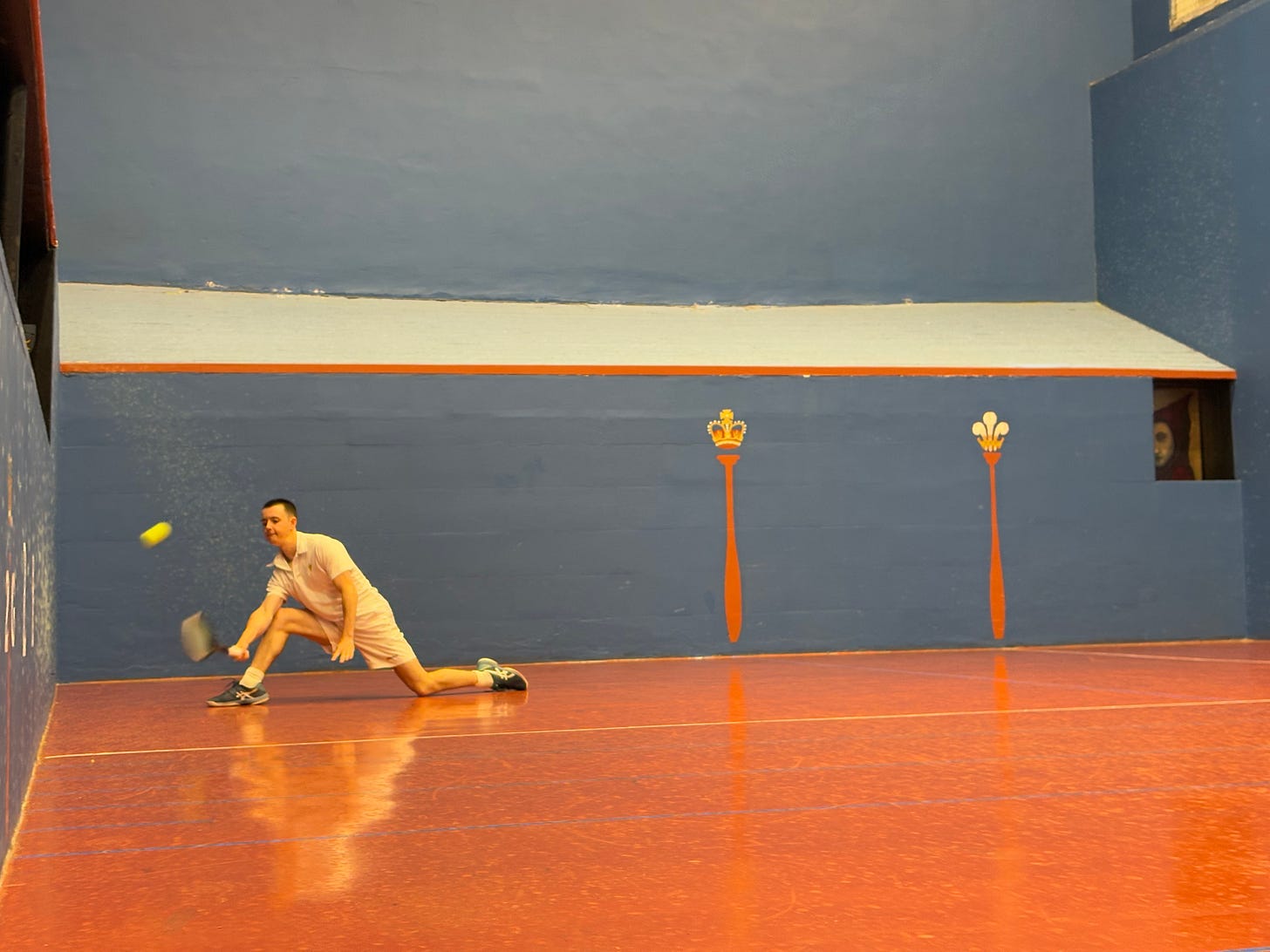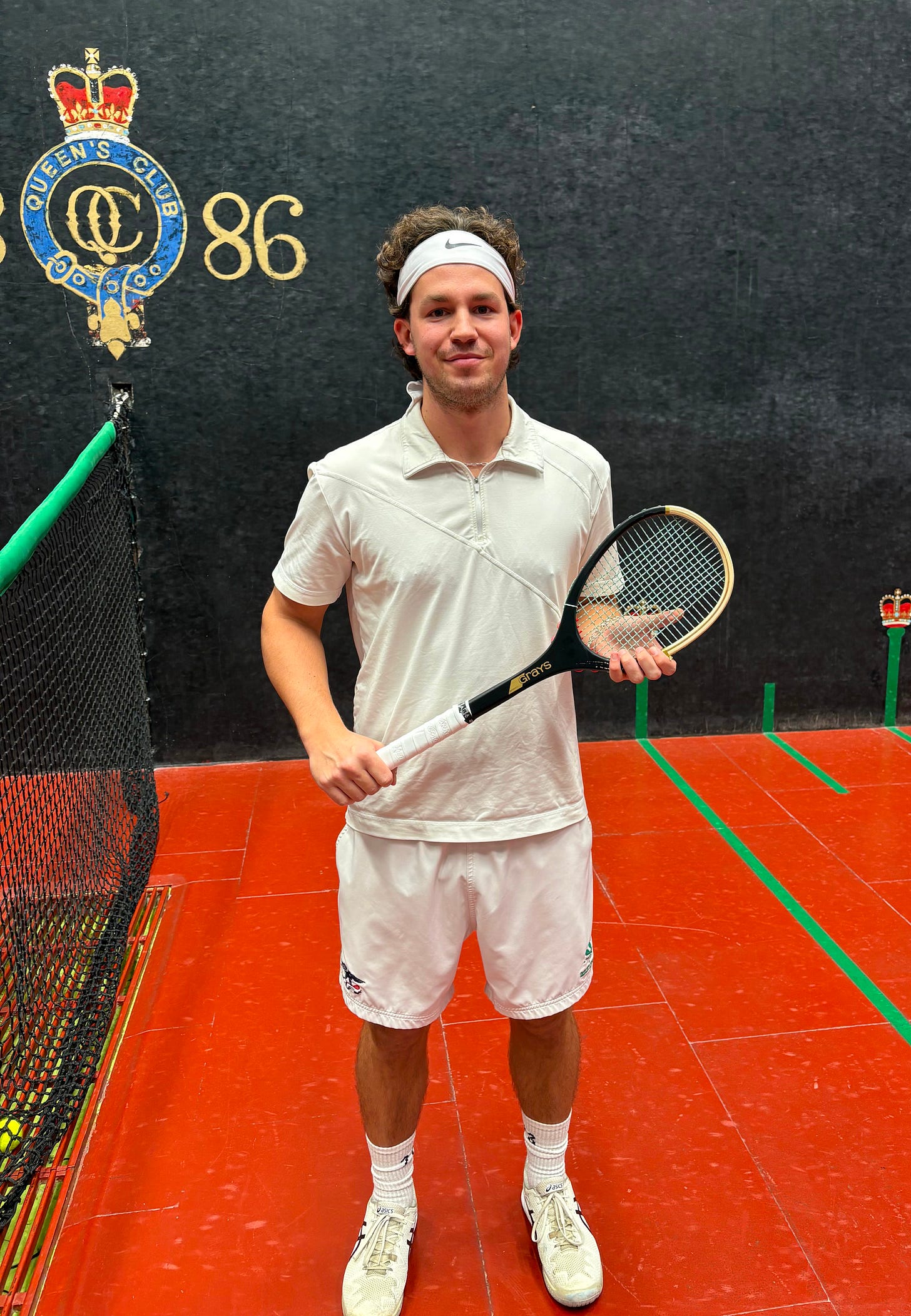The Unofficial Real Tennis Handicap World Championship
Tracking a light-hearted title through all levels of real tennis
Last fortnight, we introduced the Unofficial Real Tennis World Championship (URTWC), where instead of being challenged once every two years, the title was at stake every time the holder played a level, competitive match.
However, there is another way to propogate an unofficial title through the annals of real tennis from yesteryear — which here we call the Unofficial Real Tennis Handicap World Championship (URTHWC). The rules are similar to the URTWC, insofar as the title rests with the incumbent and may be challenged in any match. But here, any match is fair game, including both social matches and competitive matches, and both level matches and handicap matches. There is an extra twist, though. The winner of the bout is the person who walks away with a handicap win (a “W” or a “W!” on RTO), not necessarily person who won the most sets in the match. Should the players draw (i.e. receive a “D” or “N” as a handicap result), the title is retained by the incumbent.
The title began with the first ever match recorded on RealTennisOnline (RTO) in 2001: won by Mark Sayer over Andrew Fowler in Melbourne. That the title began in the geographic isolation of Australia is a key feature in its progression over its first 25 years. For it to move to another country requires either a touring player to happen to play and beat the incumbent champion, or for the incumbent champion to go on tour abroad and lose.
The URTHWC was exclusively contested in Melbourne for the first 7 years. In December 2001, the incumbent URTWC champion challenged for the URTHWC for the first and only time in either event’s history, when Mike Happell defeated Robert Fahey in a social match — an era before Category 1 status prevented top players from recording social results. Happell’s +0.9 handicap at the end of the match was the best handicap a holder of the URTWC would ever attain to date.
In 2010, the URTHWC would leave Melbourne for the first time, briefly visiting Hobart for the Clothier Cup and George Limb tryouts before returning back to Melbourne with Patrick Dunne. It didn’t last there long, returning to Hobart two months later for the Tasmanian Open Handicap Singles, where it was claimed for Hobart by Nicholas Rooke. By the end of the year, the title had reached Ballarat, where it remained for the next 12 months.
It is at this point where we introduce another rule for the URTHWC. Should the incumbent player become dormant (i.e. receive a dormancy adjustment on RTO), the title will revert to the last challenger for the title, and repropogate from them. This method is how, in 2010, the title found itself in Hobart where it would find its home for the next 13 years. Over that time, the crown has propogated up and down the Hobart membership, reaching a high watermark of a 71.8 handicap. It was rescued from dormancy once more in 2021.
A key moment in the history of the URTHWC came in late 2022 when Oliver Pridmore won the title for the first time on his way to becoming the Hobart Club Champion. Pridmore then travelled to the UK for a real tennis gap year, but lost his first match — and the first ever URTHWC match outside of Australia — in the qualifying round of the Seacourt Silver Racquet to James Medlow in February 2023. That tournament was won by Max Trueman, who defeated Medlow in the final qualifying round then took wins in each round of the main draw.
Trueman then took the URTHWC to the United States for the first time, winning the Tuxedo Gold Racquet against Noah Motz and returning with the title still in tact. For the rest of the season, the title bounced through the National League Divisions 1 and 2, with Alex Duncliffe-Vines, Zak Eadle, Will Flynn each briefly holding the title before ending the season with Claire Fahey.
In the 2023/24 season, Fahey lost the title at the Holyport Tambour Tour event — eventually ending in the hands of Levi Gale. However, it returned to Trueman following the Petworth Tambour Tour Event. Freddie Bristowe then won the title at the 2023 British U21/24’s defeating Vaughan Hamilton. Bristowe took the title back to the US and held onto the title for a full year. In that time, the URTHWC was contested in a National Open for the first time, with Bristowe scraping through the US Open qualifying with a handicap draw against John Woods-Casey and a no result loss to Bryn Sayers. Bristowe also carried the title through the 2024 British Open, with a win over Tony Hollins and another no result loss, this time to Robert Shenkman.
Bristowe finally relinquished his title in the same place he won it, at the 2024 British U21/24’s where he gave it over to Henry Henman. Despite winning the U21 title against Bertie Vallat, Vallat rechallenged on the same day in the U24 final, winning the crown on his second attempt. Medlow then took back the title for a second time, again at the 2025 Seacourt Silver Racquet, defending it through until the FLM Super League, where he lost to Henry Henman. Henman passed it on to Benedict Yorston at the Radley Club Championships. The title then went to fellow Radlean Ned Batstone at the British U26’s Invitational ahead of the Van Alen/Clothier/George Limb team events, despite Yorston winning the match.
Batstone currently holds the title going into the 2025/26 season, but given the volatile history of the championship where it will end at the conclusion of the season is anybody’s guess. Now that the URTHWC has been freed from its isolation in Tasmania and is in circulation amongst those pushing for National Open qualification, chances are that it will remain with the top players, especially given that Category 1 players (sub 10 handicap) cannot record wins or losses in social matches. In the meantime, the rest of the tennis playing population can live in hope that one day, they could find a semi-legitimate way of calling themselves a World Champion.




